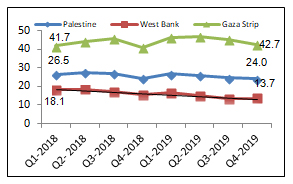the Labour Force Survey Results Fourth Quarter (October – December, 2019) Round
Unemployment Rate in Gaza Strip is Three Times Higher than in the West Bank
(Revised ILO Standards ICLS 19th)
24% was the unemployment rate among labour force participants 15 Years and Over in Palestine, total labour underutilization stands at 32%.
Using the latest Revised ILO standards ICLS 19th, the number of unemployed was 329,600 in the 4th quarter of 2019, distributed as 208,200 in Gaza Strip and 121,400 in the West Bank. The unemployment rate in Gaza Strip was 43% compared with 14% in the West Bank, while the unemployment rate for males in Palestine was 21% compared with 38% for females.
Total labour underutilization was 474,200 person including 73,100 discouraged jobseekers and 20,600 in time-related underemployment.
A large gap in the labour force participation rate between males and females
About 7 out of 10 males participated in the labor force, compared with about 2 out of 10 females.
Females participation in the labour force was 19% in Gaza Strip compared with 17% in the West Bank.
The number of employed in the local market increased between the 3rd quarter and the 4th quarter 2019
The number of the employed in the local market increased from 881 thousand in the 3rd quarter 2019 to 906 thousand in the 4th quarter 2019, which increased in Gaza Strip by 5.8%, and also in the West Bank increased by 1.6%, for the same period.
The services sector and other branches (included education and health) was the biggest employer in the local market, where the percentage of employment was more than one third of the employed in the West Bank compared with more than the half in Gaza Strip.
The average weekly hours worked by wage employees in the West Bank was 44.2 hours compared with 35.3 hours in Gaza Strip. And the average number of days worked per month was 22.5 days in both the West Bank and Gaza Strip.
The number of employed in Israel and Israeli settlements decreased by about 6,000 between the 3rd quarter and the 4th quarter 2019
The number of employed in Israel and Israeli settlements was about 135 thousand in the 4th quarter 2019, and the largest share of those who had a permit as it reached 72%, and 20% for who worked without any permit, while the percentage of who had an Israeli identity card or foreign passport was about 8%.
The number of employed in Israeli settlements was about 24 thousand in the 4th quarter 2019 compared with 22 thousand in the 3rd quarter 2019.
The construction sector recorded the highest employment rate in Israel and Israeli settlements, which was 65% of the total Palestinian employment in Israel and Israeli settlements.
The average daily wage for the wage employees in Israel and Israeli settlements decreased between the 3rd quarter 2019 and the 4th quarter 2019 from 261 NIS to 255 NIS respectively.
About 7 out of 10 employed were wage employees
71% of employed were wage employees, 25% were self-employed and employers, while 4% were unpaid family members.
About half of the wage employees in the private sector were hired without any contract.
51% of wage employees in the private sector were hired without any contract, and 27% of wage employees contributed to a pension fund. In contrast, less than half of wage female employees in private sector (47%) got a paid maternity leave.
31% of wage employees in the private sector received less than the minimum wage (1,450 NIS) in Palestine
The percentage of wage employees in the private sector who received less than the minimum wage in the West Bank increased from about 8% in the 3rd quarter 2019 to about 9% in the 4thquarter 2019, while the percentage in Gaza Strip decreased from 87% to 80% during the same period.
Despite the low percentage in Gaza Strip compared with last years the gap in the monthly wage percentage remained high; 652 NIS in Gaza Strip compared with 1,027 NIS in the West Bank.
Child labour percentage in the West Bank was higher than in Gaza Strip
3% of children aged (10-17 years) were employed about (5% in the West Bank and 1% in Gaza Strip).
 عربي
عربي
